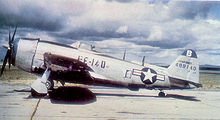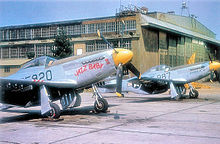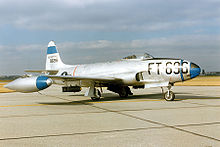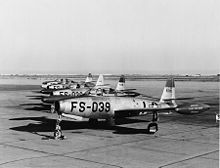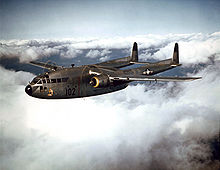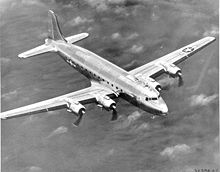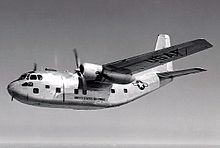- Continental Air Command
-
Continental Air Command 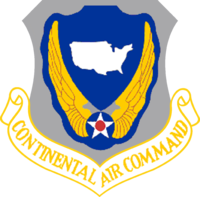
Continental Air Command emblemActive 1948 - 1968 Country United States Branch United States Air Force Type Major Command Continental Air Command (ConAC) (1944–1946; 1948–1968) was a Major Command of the United States Air Force (USAF) responsible primarily for administering the Air National Guard and Air Force Reserve.
Contents
History
Lineage
- Established as Continental Air Command, and organized, on December 1, 1948
- Inactivated on August 1, 1968
- Disestablished on September 21, 1984
Components
Agencies
- Air Defense Command, 1 December 1948 - 1 July 1950
- Tactical Air Command, 1 December 1948 - 1 December 1950
Divisions
- First Air Force, 1 December 1948-23 June 1958
- Fourth Air Force, December 1948-1 September 1960
- Ninth Air Force, 1 December 1948 - 1 December 1950
- Tenth Air Force, 1 December 1948 - 20 January 1966
- Twelfth Air Force, 1 December 1948 - 1 December 1950
- Fourteenth Air Force, 1 December 1948 - 1 July 1968
Stations
- Mitchel AAF (Later AFB), New York, 1 December 1948
- Robins AFB, Georgia, 1 April 1961 - 1 August 1968
Operational history
Origins
In 1944, the majority of the Numbered Air Forces of the United States Army Air Forces (USAAF) were fighting in various parts of the world, such as the Eighth Air Force in Europe and the Twentieth Air Force in the Pacific. They were supported by four numbered air forces located within the United States (First, Second, Third and Fourth). which was known as the Zone of the Interior, or "ZI".
On 13 December 1944, the USAAF established "Major Commands", in order to streamline command and control of wartime operations in the various theaters. First, Second, Third and Fourth Air Force were placed under Continental Air Forces (CAF), which provided command and control for USAAF forces in the ZI. CAF had been formed to oversee redeployment, provide air defense of the country, and ultimately form and command the continental strategic reserve. Similar overseas major commands for the Pacific Theater (United States Strategic Air Forces in the Pacific (USASTAF)) and European Theater (United States Strategic Air Forces in Europe (USSTAF)) were also established.
This organizational structure brought better command and control to the widely dispersed theaters and sub-theaters of the USAAF throughout the world, however with the peace in 1945 and the return of forces and subsequent demobilization, a new organizational pyramid was necessary. Entering 1946, the USAAF had a group strength less than half that of September 1945.
General Carl Spaatz, Commanding General of the AAF, ordered a reorganization to implement the lessons of World War II and provide an effective striking force in being. He faced the prospect of independence at some indeterminate future time and the immediate need to implement the markedly reduced post-war air force program. Original ideas were to have just two commands in the United States—CAF and a strategic strike force—but General Dwight D. Eisenhower's accession to the Army Chief of Staff position and his desire for tactical air units dedicated to support Army ground forces, prompted the inclusion of a tactical command. On 21 March 1946, the USAAF established a new organization of Major Commands as follows:
- Strategic Air Command (SAC), to provide a long-range striking force capable of bombardment operations in any part of the world. SAC was formed from the two strategic air forces which fought in the European Theater, the Eighth and Fifteenth Air Forces.
- Tactical Air Command (TAC), to support the operations of ground forces. TAC was formed from the Ninth and Twelfth Air Forces, the primary tactical air forces in the European Theater.
- Air Defense Command (ADC), to defend the United States against attack from the air. ADC was created from the former Continental Air Forces First, Second, and Fourth Air Forces, along with the Tenth Air Force which had returned from India and the Fourteenth Air Force which has returned from China.
In addition, several overseas-based Major Commands were established to command USAAF forces outside of the Continental United States (CONUS). These were:
- Far East Air Forces (FEAF), consisting of the Fifth, Seventh, Thirteenth and Twentieth Air Forces in the former Pacific Theater.
- United States Air Forces in Europe (USAFE) to command forces in the former European Theater. Third Air Force was reassigned from the ZI to USAFE to perform intermediate level command functions.
- Sixth Air Force was redesignated Caribbean Air Command and elevated to Major Command status to command USAAF forces in Central America and various Caribbean island bases.
- Eleventh Air Force was redesignated Alaskan Air Command and elevated to Major Command status to command USAAF forces in Alaska and the Aleutian Islands.
With the establishment of these seven major commands, all reporting to Headquarters USAAF, the wartime Major Commands (CAF, USSTAF, USASTAF) were inactivated. Although modified and expanded , this basic organizational structure has remained in place for United States Air Force the past sixty years.
ConAC Establishment
In 1947 the United States Congress provided the necessary legislation to create a Department of Defense and established the United States Air Force (USAF) as a separate service equal to the Army and the Navy in the nation's military establishment.
During World War II there were massive deficit expenditures to conduct the war, however with the peace, the Truman Administration was determined to bring the Federal budget back into balance. This meant that there was little money for the Air Force to modernize its forces. What money was there, was allocated first to SAC for new B-50 Superfortress and B-36 Peacemaker intercontinental bombers, along with F-82 Twin Mustang fighter escorts. All of these three weapon systems were developed during the war and put into production to replace the obsolete B-17, B-24 and war-weary B-29 strategic bomber fleet inherited by SAC. The appearance of the German jet aircraft during the war essentially made obsolete the prop-driven P-47 Thunderbolt and P-51 Mustang fighters inherited by TAC. F-80 Shooting Star and F-84 Thunderjet jet aircraft, also developed during the war were put into production to replace them. ADC received the many training P-47 and P-51 fighters used at CONUS bases during the war, along with the already produced P-47N and P-51H long-range escort aircraft designed for use in the expected Invasion of Japan. In addition, large numbers of Northrup F-61C Black Widows, used for night fighter operations during the war found their way into ADC units.
Due to the limited budget, the new USAF was forced to extend procurement of these aircraft to just a few each year. As a result of limited budgets Continental Air Command (ConAC) was established on 1 December 1948 as a new major command. ConAC was the result of an effort by the new USAF to concentrate all fighter forces deployed within the continental United States to strengthen the air defense of the North American continent. With the establishment of ConAC, TAC and ADC were reduced from major commands to operating agencies under ConAC. ConAC also had charge of all Air Force Reserve units because most of these forces were to be used in either air defense or tactical operations.
In practice, ConAC was unworkable as the tactical air support mission was fundamentally different than the air defense mission. Units assigned to ConAC were dual-trained and in case of war, were expected to revert to their primary roles after the North American air defense battle was won.
With the outbreak of the Korean War in June 1950, it was necessary to deploy large numbers of tactical aircraft to Japan and South Korea. In addition, the need to support the new NATO alliance meant that entire wings of aircraft would be deployed to Europe for tactical air defense. On 1 December 1950, the Air Force reestablished Tactical Air Command as a major command and relieved it from assignment to ConAC. TAC's mission would be to supply these tactical forces to FEAF and USAFE, and also be able to deploy its CONUS forces worldwide in response to Cold War threats by Communist China and the Soviet Union.
The air defense mission, relegated to a secondary status in the postwar years, received much more attention as Cold War tensions heightened. Following the explosion of a Soviet nuclear weapon in August 1949, the Air Force issued requirements for an operational air defense system by 1952. The perceived threat of an airborne atomic attack by the Soviet Union with its Tu-4 copy of the B-29 or Tu-95 strategic bomber led to the separation of Air Defense Command from ConAC, and its reestablishment as an Air Force major command, effective 1 January 1951 to counter the perceived Soviet threat.
Reserve/National Guard Mission
With the reestablishment of TAC and ADC as major commands, ConAC's misson became one of administering Air Force Reserve Troop Carrier units. Beginning in the mid-1950s and lasting through the 1960s, all Continental Air Command flying units were Air Force Reserve troop carrier units were upgraded from the C-47/C-54 to either C-118 Cargomaster, C-119 Flying Boxcar, C-123 Provider, or C-124 Globemaster aircraft. Continental Air Command flying units also included Air Force Reserve Air Rescue Squadrons which were equipped with the amphibious SA-16 / HU-16 Albatross from their inception.
Several major re-organizations occurred to Continental troop carrier wings. Their original Table of Organization was a wing headquarters, a troop carrier group, an Air Base Group, a maintenance and supply group, and a medical group. In 1957, the troop carrier group and maintenance and supply groups were inactivated, with their squadrons reassigned directly to the wing headquarters - despite the fact that many wings had squadrons spread out over several bases due to centers of population.
Following a series of mobilizations in 1961 and 1962 for the Berlin Crisis and the Cuban Missile Crisis, Continental Air Command realized that it was unwieldy to mobilize an entire wing unless absolutely necessary. Therefore, in 1963, the wings were again reorganized. Troop Carrier Groups were activated at every base that held a CONAC troop carrier squadron, with each group comprising a material squadron, a troop carrier squadron, a tactical hospital or dispensary, and a combat support squadron. Each troop carrier wing consisted of 3 or 4 of these groups. By doing so, CONAC could facilitate the mobilization of either aircraft and aircrews alone, aircraft and minimum support personnel (one troop carrier group), or the entire troop carrier wing.
While these troop carrier groups have been redesignated several times through the decades with changes in missions and aircraft (the Air Force Reserve Command now operates several different types of aircraft, not all of which are transports), many still exist and today are designated as Wings.
Continental Air Command was inactivated on 1 August 1968 and was replaced by the Air Force Reserve (AFRES). AFRES was initially a field operating agency, later redesignated Air Force Reserve Command on 17 February 1997 and status changed from a field operating agency to a major command of the United States Air Force.
Continental Air Command was disestablished on 21 September 1984. CONAC installations, many of which are still active today as Air Force Reserve or Air National Guard installations, included:
- Andrews AFB, Maryland
- Bakalar AFB, Indiana
- Barksdale AFB, Louisiana
- Brookley AFB, Alabama
- Carswell AFB, Texas
- Clinton County AFB, Ohio
- Dobbins AFB, Georgia
- Ellington AFB, Texas
- Grenier AFB, New Hampshire
- Hanscom AFB, Massachusetts
- Hamilton AFB, California
- Homestead AFB, Florida
- Luke AFB, Arizona
- March AFB, California
- McGuire AFB, New Jersey
- Mitchell Field, Wisconsin
- NAS/JRB New Orleans, Louisiana
- Niagara Falls IAP, New York
- McClellan AFB, California
- Paine AFB, Washington
- Pittsburgh IAP, Pennsylvania
- Portland IAP, Oregon
- Richards-Gebaur AFB, Missouri
- Robins AFB, Georgia
- Scott AFB, Illinois
- Selfridge AFB, Michigan
- Stewart AFB, New York
- NAS/JRB Willow Grove, Pennsylvania
- Youngstown AFB, Ohio
References
- Maurer, Maurer (1983). Air Force Combat Units Of World War II. Maxwell AFB, Alabama: Office of Air Force History. ISBN 0892010924.
- The Air Officer's Guide, 1970-1971 Edition, United States Air Force, ISBN 0811726096
- Continental Air Command at US Air Force Historical Research Agency
External links
 This article incorporates public domain material from websites or documents of the Air Force Historical Research Agency.Categories:
This article incorporates public domain material from websites or documents of the Air Force Historical Research Agency.Categories:- 1948 establishments
- Major commands of the United States Air Force
- Cold War
Wikimedia Foundation. 2010.

